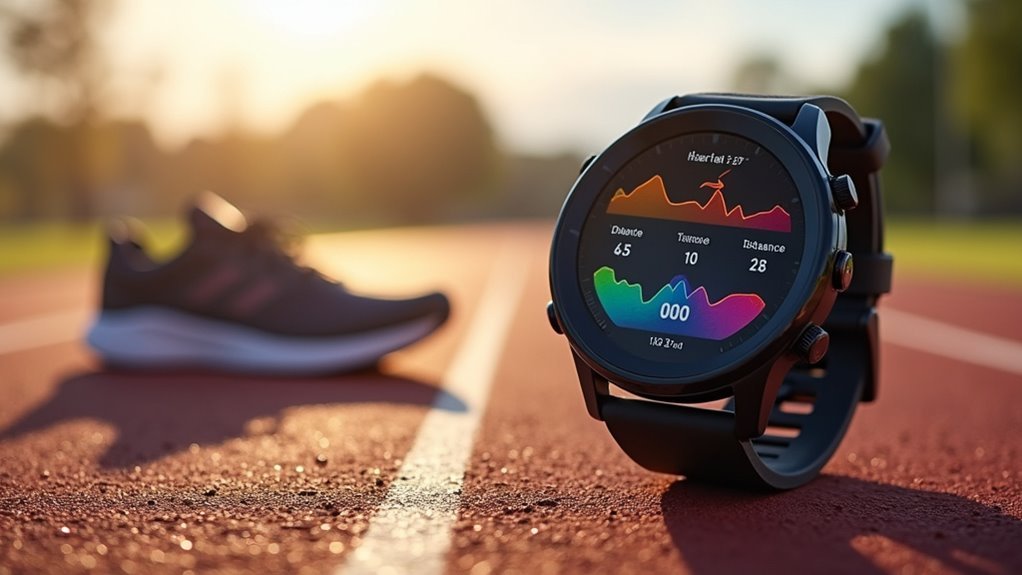You should focus on five critical running metrics to optimize your performance: Ground Contact Time (GCT) measures how long your feet touch the ground, with shorter times indicating better efficiency. Cadence tracks your steps per minute, with 180+ being ideal for speed and injury prevention. Vertical Oscillation monitors your up-and-down movement, keeping it between 5-10 centimeters to minimize energy waste. GCT Balance detects left-right asymmetries that increase energy costs. Hard Running Distance quantifies high-intensity efforts above 4.5 m/s, helping prevent overtraining while tracking your power development and sprint capacity improvements.
Ground Contact Time: The Key to Running Efficiency

When your foot strikes the ground during each running stride, the duration it remains in contact—known as Ground Contact Time (GCT)—directly influences your running efficiency and speed.
Elite runners consistently demonstrate shorter GCT, which increases airborne time and enhances performance. You’ll find that reducing your GCT requires greater force production, benefiting both economical and high-speed running.
Shorter ground contact time equals greater explosive force production, directly translating to improved running economy and enhanced speed performance.
Studies reveal a negative correlation between GCT and running speed—faster runners maintain shorter contact times. Your GCT varies based on biomechanical factors like stride length, muscle strength, and running technique.
Midfoot or forefoot striking can help reduce contact time compared to heel striking. The position of your foot at footstrike significantly impacts your contact time, as landing with your foot in front of your body’s center of gravity increases the duration spent on the ground.
You can optimize your GCT through plyometric exercises, sprint intervals, and hill training, which improve explosive force production and stride frequency for enhanced running efficiency.
Cadence Optimization for Better Speed and Injury Prevention
While Ground Contact Time focuses on the duration your foot touches the ground, cadence measures how frequently your feet strike the pavement—typically expressed as steps per minute. Enhancing your cadence can dramatically improve both your speed and injury prevention strategy.
Research shows that increasing cadence reduces energy costs by 3-7%, with untrained runners experiencing greater benefits. Higher cadence also minimizes impact on your joints, reducing overuse injury risk through improved biomechanics. Studies reveal that trained runners naturally maintain higher self-selected cadences compared to their untrained counterparts.
Here’s how to enhance your cadence:
- Target 180+ steps per minute for ideal performance and efficiency
- Use a metronome during training to gradually increase your natural rhythm
- Monitor progress with wearable devices to track consistency and improvements
- Personalize your approach based on your current fitness level and running goals
Vertical Oscillation: Minimizing Energy Waste in Every Stride

Although you’ve optimized your cadence and ground contact time, excessive vertical bounce can still sabotage your running efficiency.
Vertical oscillation measures your up-and-down movement during each stride, with ideal ranges between 5-10 centimeters. When you bounce above 10cm, you’re wasting precious energy that should propel you forward instead of upward.
Track your vertical oscillation using GPS watches, running pods, or video analysis to identify inefficiencies. Most runners over-bounce rather than under-oscillate, especially when overstriding.
You can reduce excessive vertical movement by increasing your cadence, which minimizes ground contact time and promotes smoother forward motion. Tight calf muscles and stiff ankle joints contribute to excessive vertical oscillation.
Focus on landing with your feet closer to your center of gravity. Practice running drills like high knees and incorporate strength training to develop proper mechanics that channel energy horizontally.
Ground Contact Time Balance: Detecting Asymmetries Before They Become Problems
Even if you’ve mastered vertical oscillation control, subtle differences in how long each foot contacts the ground can quietly undermine your running efficiency and set you up for injury.
Ground contact time balance measures the symmetry between your left and right foot’s ground contact duration. When this balance shifts, you’re burning extra energy while placing uneven stress on muscles and joints. The uneven distribution helps prevent increased stress on muscles, joints, and ligaments when properly balanced.
Research shows that just a 1% increase in ground contact time imbalance leads to a 3.7% spike in metabolic costs. Modern devices like Garmin’s running dynamics pods can detect these asymmetries before they become problematic.
Key warning signs to monitor:
- Persistent muscle soreness on one side after runs
- Gradual performance decline despite consistent training
- Recurring minor injuries on the same leg
- Noticeable fatigue increases during longer runs
Hard Running Distance and Work Rate: Measuring High-Intensity Performance
Beyond maintaining symmetrical ground contact, you need to track how much distance you’re covering at high speeds and the intensity you’re sustaining throughout your runs.
Hard running distance measures your total volume when running faster than 4.5 m/s for longer than one second. This metric’s vital for monitoring fatigue levels and preventing overtraining while serving as a strong performance indicator.
Work rate calculates your total distance relative to time, demonstrating the physical demands of each session. It enables you to compare intensity levels across different workouts and track performance changes over time. Regular exposure to sprint efforts reduces likelihood of soft tissue injuries.
Together, these metrics help you manage workload effectively and plan training sessions by adjusting intensity based on your current performance capabilities, ensuring ideal adaptation without burnout.
Frequently Asked Questions
How Often Should Runners Measure Their Performance Metrics During Training?
You should measure heart rate and mileage after each run, track cadence and pace weekly during key workouts, and test running economy every four to eight weeks for ideal training progress.
Which Running Watch or Device Provides the Most Accurate Metric Measurements?
You’ll find Polar Vantage watches offer the most accurate heart rate monitoring, while Coros excels in GPS tracking under challenging conditions. Garmin Forerunner models provide reliable overall metrics with excellent battery life for thorough accuracy.
Can Running Performance Metrics Help Predict Race Times and Goals?
You can definitely use running performance metrics to predict race times and goals. Distance, pace, elevation gain, training load trends, and VO2 max scores feed into LSTM models and algorithms that’ll forecast your future performances accurately.
Do Performance Metrics Differ Significantly Between Treadmill and Outdoor Running?
Performance metrics don’t differ considerably between treadmill and outdoor running at slower speeds. However, you’ll notice differences at faster paces due to reduced air resistance, requiring treadmill incline adjustments for accuracy.
What’s the Ideal Training Load Progression Based on Performance Metric Data?
You should increase your weekly training load by 10-15% maximum, combining external metrics like distance with internal measures like perceived exertion and heart rate to optimize performance while preventing injury.
In Summary
You’ve got the tools to transform your running performance. Track your ground contact time to boost efficiency, optimize your cadence to run faster while staying injury-free, and minimize vertical oscillation to stop wasting energy. Monitor your ground contact time balance to catch asymmetries early, and use hard running metrics to gauge your high-intensity efforts. Start measuring these five metrics consistently, and you’ll see measurable improvements in your running performance within weeks.





Leave a Reply